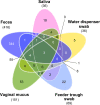Characterization of pig saliva as the major natural habitat of Streptococcus suis by analyzing oral, fecal, vaginal, and environmental microbiota
- PMID: 31017953
- PMCID: PMC6481863
- DOI: 10.1371/journal.pone.0215983
Characterization of pig saliva as the major natural habitat of Streptococcus suis by analyzing oral, fecal, vaginal, and environmental microbiota
Abstract
It is generally difficult to specify the sources of infection by which domestic animals may acquire pathogens. Through 16S rRNA gene amplicon sequencing, we compared the composition of microbiota in the saliva, vaginal mucus, and feces of pigs, and in swabs of feeder troughs and water dispensers collected from pig farms in Vietnam. The composition of the microbiota differed between samples in each sample group. Streptococcus, Actinobacillus, Moraxella, and Rothia were the most abundant genera and significantly discriminative in saliva samples, regardless of the plasticity and changeability of the composition of microbiota in saliva. Moreover, species assignment of the genus Streptococcus revealed that Streptococcus suis was exceptional in the salivary microbiota, due to being most abundant among the streptococcal species and sharing estimated proportions of 5.7%-9.4% of the total bacteria in saliva. Thus, pig oral microbiota showed unique characteristics in which the major species was the pig pathogen. On the other hand, β-diversity analysis showed that the microbiota in saliva was distinct from those in the others. From the above results, pig saliva was shown to be the major natural habitat of S. suis, and is suggested to be the most probable source of S. suis infection.
Conflict of interest statement
The authors have declared that no competing interests exist.
Figures






References
-
- Goyette-Desjardins G, Auger JP, Xu J, Segura M, Gottschalk M. Streptococcus suis, an important pig pathogen and emerging zoonotic agent-an update on the worldwide distribution based on serotyping and sequence typing. Emerg Microbes Infect. 2014;3(6):e45 Epub 2015/06/04. 10.1038/emi.2014.45 - DOI - PMC - PubMed

